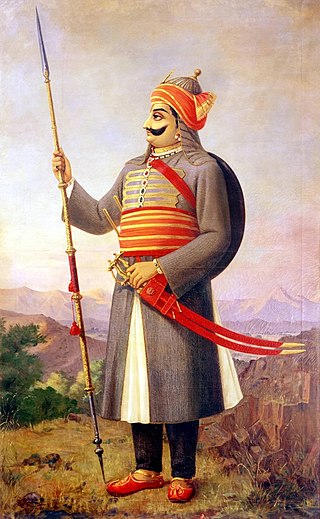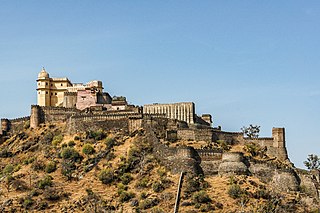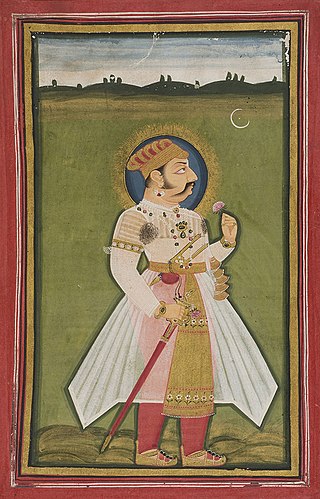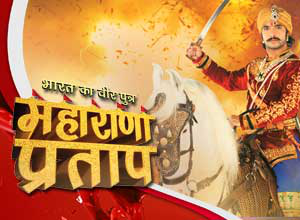
Pratap Singh I, popularly known as Maharana Pratap, was a king of Kingdom of Mewar, in north-western India in the present-day state of Rajasthan. He is notable for leading the Rajput resistance against the expansionist policy of the Mughal Emperor Akbar including the Battle of Haldighati.

Kumbhalgarh, also known as the Great Wall of India, is a fortress on the westerly range of Aravalli Hills in the Rajsamand district of the Rajasthan state in India. Situated approximately 84 km (52 mi) from Udaipur, it was built during the 15th century by Rana Kumbha. The wall of Kumbhalgarh is one of the longest continuous walls in the world, spanning 38 kilometers. It is also the birthplace of great king and military leader Maharana Pratap of Mewar.
Gogunda is a town and tehsil headquarters of Gogunda Tehsil in Udaipur district, located about 35 km (22 mi) in north-west from Udaipur city in the Indian state of Rajasthan. It is situated on a high mountain in Aravalli hills and is reached by crossing a difficult mountain pass.

Rana Kumbha or Kumbhkaran Singh (1433–1468), popularly known as Maharana Kumbha, was the ruler of the Kingdom of Mewar. He belonged to the Sisodia clan of Rajputs. It was during his reign that Mewar became one of the most powerful political powers in northern India. He is considered to be the most powerful ruler of his time in India.

The battle of Haldighati was fought on 18 June 1576 between the Mewar forces led by Maharana Pratap, and the Mughal forces led by Man Singh I of Amber. The Mughals carried the day after inflicting significant casualties on Mewar forces, although they failed to capture Pratap, who reluctantly retreated persuaded by his fellow commanders.

Udai Singh II was the Maharana of Mewar and the founder of the city of Udaipur in the present-day Rajasthan state of India. He was the 12th ruler of the Kingdom of Mewar. He was the fourth son of Rana Sanga and Rani Karnavati, a princess of Bundi.
Hakim Khan Sur An ethnic Pashtun, was a descendant of Sher Shah Suri and a general in Rana Pratap's army. He fought with him in the Battle of Haldighati and died in 1576. In Haldighati Battle, he commanded an army of Afghans who were against the rising power of Mughal Empire.

The Kingdom of Mewar, also called Medapata, was an independent kingdom that existed in the Rajputana region of the Indian Subcontinent and later became a dominant state in medieval India. The kingdom was initially founded and ruled by the Guhila dynasty followed by the Sisodiya Dynasty. The earliest kingdom was centered around the south-central part of Rajasthan, state of India. It was bordered by the Aravali Range to the northwest, Ajmer to the north, Gujarat, Vagad and Malwa regions to the south and the Hadoti region to the east.
Bhainsrorgarh Fort or Bhainsror Fort is an ancient fort that has become a major tourist spot in the state of Rajasthan, India.

Shahrullah Kamboh, better known as Shahbaz Khan Kamboh, was one of the leading generals of Mughal emperor Akbar. He participated in some of the most difficult expeditions of Akbar and annexed numerous territories to the empire. The Mughal officials boasted that he conquered countries ten times the size of Deccan. He was too orthodox a Sunni Muslim for Akbar's taste, but not only was he tolerated but also was greatly valued. He was named "Mang Khan" by the people of Lahore meaning "ask the Khan and it will be done" In Punjabi due to his legendary generosity. The very first 'guzar' in Lahore Fort was named Guzar Shahbaz Khan known locally as Guzar Mang Khan.
The Mughal–Rajput wars were a series of battles between the Rajput Confederacy and the Mughal Empire. The conflicts originated with the invasion of northwestern India by the Mughal ruler Babur, to which the head of the Rajput confederacy, Rana Sanga, offered staunch resistance. The conflicts went on since 1526 for over 200 years, with the Mughals having the upper hand until the death of Aurangzeb in 1707, following which they entered a declining phase and the Rajputs gained the upper hand, with the last recorded conflict being in 1779.

Maharana Pratap: The First Freedom Fighter is an Indian epic film based on Maharana Pratap of Mewar .The film is directed and produced by Dr. Pradeep Kumawat from Udaipur, Rajasthan. It is the first time that a film has been made on the history of Maharana Pratap. The film's sound track includes one of the last songs sung by Late Jagjit Singh.

Bharat Ka Veer Putra – Maharana Pratap is an Indian historical fiction series produced by Contiloe Entertainment. It is based on the life of Maharana Pratap, a sixteenth century ruler of Mewar kingdom. It starred Sharad Malhotra, Rachana Parulkar, Faisal Khan and Roshni Walia.

Maharana Amar Singh I, the Maharana ruler of Mewar Kingdom, was the eldest son and successor of Maharana Pratap I. He was the 14th Rana of Mewar, ruling from January 19, 1597 till his death on January 26, 1620.
The Battle of Dewair (Dewar) was fought between Amar Singh I of Mewar and Mughal army led by Jahangir under Muhammad Parviz and Asaf Khan III. Shortly after his accession in 1606, Jahangir sent an army of 20,000 cavalry to attack Mewar. Parviz was only the figurative commander while in reality the de facto commander was Jahangir who directed Asaf Khan. Amar led a hard fought battle to defend his territory, and personally killed the Mughal commander Sultan Khan and his horse by spear which went through both. Reportedly, Asaf Khan retreated from the battlefield. Both Amar and Asaf Khan claimed victory in an indecisive battle.
Shakti Singh Sisodia Mewar was the son of Maharana Udai Singh II Sisodia and Rani Sajja Bai Solanki. He was a Kshatriya Rajput and was younger brother of famous Maharana Pratap, He was also the eponymous founder of the Shaktawat clan of Sisodia Rajputs.
The Prince Salim's Invasion of Mewar was a military expedition of the Mughal empire towards the Rajputs of Mewar. After the invasion by Jagannath Kachwaha in 1585, the Mughal Empire did not launch any major expeditions to Mewar until Maharana Pratap's death in 1597 A.D. From 1585 until his death, Maharana Pratap didn't face any invasions from the Mughals as the Emperor Akbar was preoccupied with internal matters and expeditions to Afghanistan. Following Maharana Pratap's death in 1597 A.D., his son Amar Singh assumed his father's mantle over certain areas of Mewar. A new expedition, led by the then Prince Salim, also known as Prince Salim, accompanied by Man Singh, was launched with the objective of weakening the power of Mewar. This attempt took place in 1599 A.D. or in 1600 A.D.

The Mewar- Malwa conflict was a series of wars between the Kingdom of Mewar and the Islamic Sultanate of Malwa. The conflict erupted due to mutual territorial expansion triggered by both sides on each other. The war was fought in what is now known as the Indian states of Rajasthan and Madhya Pradesh. The Rana branch of the Guhilas, following their successful recovery of the Rajput stronghold of Chittorgarh and the entire region of Mewar alongside Rajputana after the Battle of Singoli, embarked on an ambitious expansion at the cost of their neighboring kingdoms. On the other side, with the invasion of Timur, the Lame Delhi Sultanate grew weak with its multiple subahs gaining independence which included Malwa, adjacent to Mewar.
















